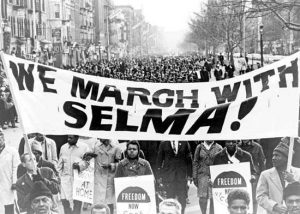Center for Mass Communication at Columbia University, Selma-Montgomery March, 1965
In January 1965, civil rights movement leader Martin Luther King, Jr., brought his Southern Christian Leadership Conference to Selma, Alabama, after the local Dallas County Voter’s League invited them to participate in their voting rights campaign (Fairclough 2000). The Student Nonviolent Coordinating Committee had been working with Amelia Boynton’s Voter’s League because it had one of the worst records in the country in terms of the low numbers of African American citizens on the voting rolls (Jeffries 2009). In March of 1965, after local police tried to brutally suppress a Selma-to-Montgomery march once already, hundreds of African American and white citizens from Alabama and across the country successfully marched from Selma to Montgomery to protest the disenfranchisement of African Americans. During the course of the march, Columbia University’s Center for Mass Communication compiled first-hand footage that shows both leaders and ordinary US citizens’ participation in the demonstration through song, speeches and the march itself.

The 1965 Voting Rights Act
The Selma march is widely credited for resulting in landmark legislation, the 1965 Voting Rights Act (Fairclough 2000; Anderson 2016). The opening paragraph of this legislation, which is excerpted below, explicit linked Jim Crow’s disenfranchisement tools such as poll taxes to the objective of removing democratic power from African Americans. The Voting Rights Act outlawed poll taxes, literacy tests and “other bureaucratic restrictions [used] to deny” African Americans the vote, and it also provided federal oversight in areas (like Dallas County, Alabama) where the numbers of Black Americans on the voting rolls had been kept particularly low by white registrars. Because other provisions of the Act were locally enforced – meaning that they could often be ignored without federal oversight or pressure – the full power of black voters was not realized (Anderson 2016; Anderson 2018). Still, voting rolls swelled because of the Voting Rights Act. In Mississippi, for instance, voter turnout amongst African Americans went from 6% in 1964 to 59% in 1969 (Fairclough 2002, 253).
This “act to enforce the fifteenth amendment to the Constitution” was signed into law 95 years after the amendment was ratified. In those years, African Americans in the South faced tremendous obstacles to voting, including poll taxes, literacy tests, and other bureaucratic restrictions to deny them the right to vote. They also risked harassment, intimidation, economic reprisals, and physical violence when they tried to register or vote. As a result, very few African Americans were registered voters, and they had very little, if any, political power, either locally or nationally.
Link to full document: https://www.ourdocuments.gov/doc.php?flash=false&doc=100
